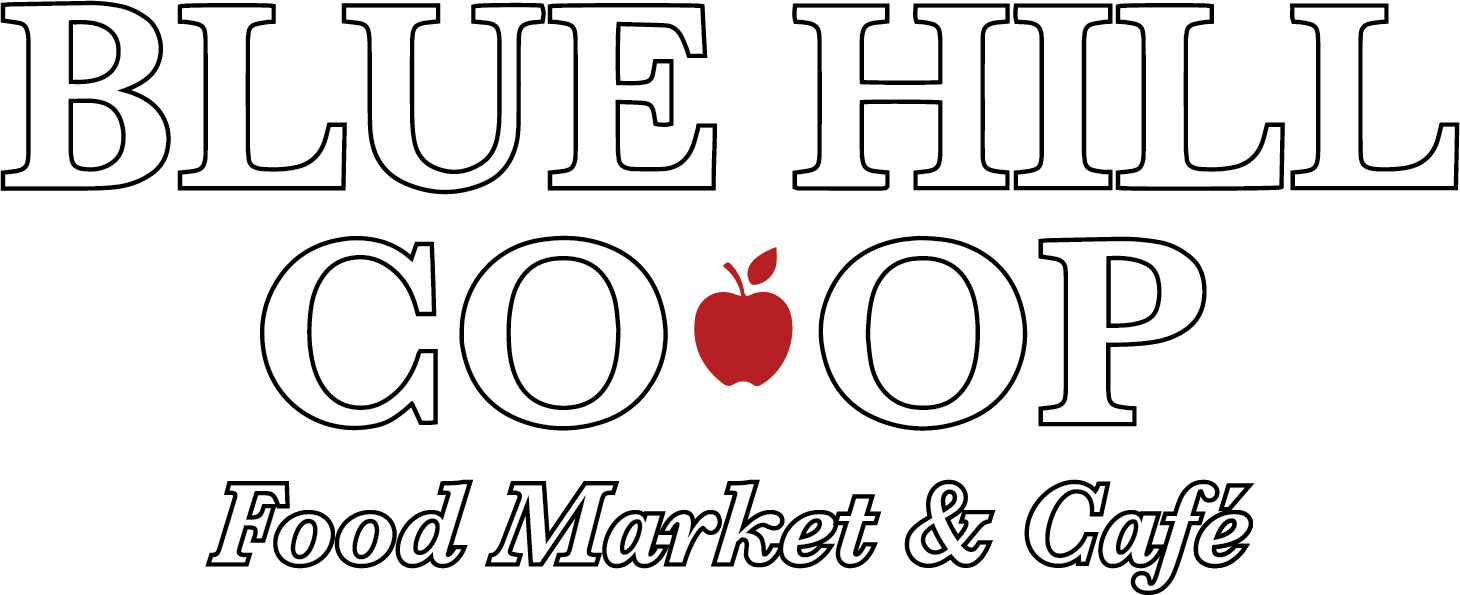What's a Co-op?
Co-op is more than just a name. Blue Hill Co-op is one of thousands of businesses and organization around the world that follow the cooperative model.
Cooperatives are member-owned, member-governed businesses, which operate for the benefit of their members (aka owners). Co-ops start with people who join together to meet a need. By investing capital or labor, they can participate in a democratically run organization, that operates to benefit the people who use it and their community. Cooperatives are not nonprofits, but rather than being solely profit-centered like many conventional businesses, Co-ops strive to function on a triple-bottom line of people, planet, & profits.
There are a lot of different types of cooperatives, from food co-ops to credit unions to mutual insurances to worker-owned farms. But all cooperatives contain the following elements:
Co-ops are owned & governed by their primary users
(the owners)
Co-ops are democratically governed
(one owner = one vote)
Co-ops are businesses, not clubs or associations*
Co-ops adhere to internationally recognized principles
(The Seven Cooperative Principles)
*Consumer cooperatives are very different from large member-based “discount clubs,” which charge annual membership fees in exchange for a discount on purchases, the owners of which are removed from the local community. Consumer co-ops are centered on the local community’s needs, and the business is actually owned by the people who shop there.
The Seven Cooperative Principles
Open & Voluntary Membership
“Cooperatives are voluntary organizations, open to all persons able to use their services and willing to accept the responsibilities of membership, without gender, social, racial, political, or religious discrimination.”
_____________
The owners (members) are the most important part of a cooperative. Without dedicated and participating owners, no co-op can succeed. To gain such a group of individuals, all co-ops need to remain voluntary organizations with ownership opportunities for all. They should be open to any persons who are able and willing to join, accept responsibility as a part of the organization and can use the organization’s services.
A co-op also protects owners and interested individuals from any form of discrimination. Cooperatives accept members voluntarily, meaning they cannot discriminate based on gender, sexuality, social status, race, political affiliation, religion or any other personal details. As long as individuals are willing to follow the core principles and values of the co-op, they can become owners.
This principle protects the fundamental human rights of interested individuals and owners. It establishes that no person or organization can turn an individual into a willing co-operator and that their involvement has to come from a place of genuine interest. The voluntary ownership also provides individuals with freedom of association. They can exercise their free will and decide if and when they wish to join and leave the organization.
Democratic Member Control
“Cooperatives are democratic organizations controlled by their members, who actively participate in setting their policies and making decisions. Persons serving as elected representatives are accountable to the membership. In primary cooperatives members have equal voting rights (one member, one vote) and cooperatives at other levels are organized in a democratic manner.”
_____________
Cooperatives are founded on the ideals of democracy. Every member plays an integral role in making decisions that affect the organization as a whole. The cooperative makes crucial choices, adds or reforms policies and elects new representatives as a group. All of the owners have equal voting rights, with one ballot per ownership, and elected officials hear every person’s voice.
Since all owners are affected by the co-op’s choices, as they all hold the same status, it’s natural that they should have the power of decision. It’s a vital part of all operations, from the day-to-day schedules to broader issues that will affect the future of the co-op. Providing a democratic structure ensures all owners have a fair stake in the organization and that their opinions and observations are considered. Healthy debate is also essential for a working democracy.
Beyond creating a fair method of decision-making, it engages all owners and serves as an incentive to participate. If members know their votes count and are valuable to the good of their organization, they will be more willing to participate in democratic practices as well as daily operations. Democracy also ensures those in elected positions are held accountable for their actions. If owners decide an official is abusing their power or not considering the good of all owners, they can take steps to solve the issue as a group.
_____________
How can you participate in your co-op’s democracy? Stay engaged. Sign up for our emails and follow us on social media. That way, you’ll know if an issue comes up that you’d like to weigh in on. At anytime, you can email our Board of Directors or drop a letter in their box (found by the community boards). Board meetings are also open to owners and there is a time period set aside for owner participation. These meetings take place on the fourth Thursday of the month at 6pm. Most importantly, vote in the annual election. If you’re interested in running for a seat on the Board of Directors, you can find information here.
Member Economic Participation
“Members contribute equitably to, and democratically control, the capital of their cooperative. At least part of that capital is usually the common property of the cooperative. They usually receive limited compensation, if any, on capital subscribed as a condition of membership. Members allocate surpluses for any of all of the following purposes: developing the cooperative, possibly by setting up reserves, part of which at least would be indivisible; benefiting members in proportion to their transactions with the cooperative; and supporting other activities approved by the membership.”
_____________
To maintain fairness in all areas of the cooperative, owners need to contribute equitably to its economy. They should also maintain democratic control over the collected capital. A portion of the capital is considered the property of the group.
Should there be any surplus capital, the owners decide where to distribute the money. Surpluses typically go towards:
- Developing the cooperative or creating reserves
- Benefitting owners equitably based on their transactions
- Supporting ownership-approved activities
Creating an equitable and democratic economy is essential for several reasons. For one, it establishes that capital supports business pursuits but doesn’t rule how the cooperative operates. Money should always be considered a servant of the owners. It is a means by which the co-op can develop and grow. Additionally, creating a democratic process for allocating capital ensures the co-op spends it with its people in mind and prevents any major excess.
Autonomy and Independence
“Cooperatives are autonomous, self-help organizations controlled by their members. If they enter into agreements with other organizations, including governments, or raise capital from external sources, they do so on terms that ensure democratic control by their members and maintain their cooperative autonomy.”
_____________
While each owner has their own freedoms within the cooperative, the organization itself is also an autonomous and independent entity. The owner of the co-op determine everything it does, which allows the co-op to function independently. The organization needs to be self-sustaining for each member to be able to exercise his or her freedoms within the structure.
The autonomy of the cooperative is also essential to outside collaboration. Co-ops can decide to enter business relationships with other organizations or raise additional capital from outside investors or sources. This principle ensures they keep their democratic and independent structure regardless of who they enter into agreements with. It even extends to arrangements between co-ops and external governments. The terms and conditions should always include group autonomy.
Maintaining an autonomous and democratically run organization is essential to cooperation. Without these two factors, co-ops would have no self-identity and would have no unique connections to share. They also ensure the members can continue to run the co-op by self-governing, regardless of their relationships and agreements with commercial entities and national governments. Securing democratic practices is especially important when it comes to working with sources of capital.
Education, Information, and Training
“Cooperatives provide education and training for their members, elected representatives, managers, and employees so they can contribute effectively to the development of their cooperatives. They inform the general public–particularly young people and opinion leaders–about the nature and benefits of cooperation.”
_____________
To run a co-op successfully, promoting and spreading education is a necessity. Every individual involved with a cooperative needs to be well informed about the way they operate, their purposes and the responsibilities of each person. Owners, employees, managers and elected officials all need continual training as the cooperative evolves and changes over time. If they are well versed in the co-op’s policies, regulations, values and principles, they’ll all be able to contribute more effectively to its development.
But education shouldn’t stop at the cooperative’s internal members. It should also extend to the surrounding community and the general public. Owners can teach others about the beneficial nature of cooperative businesses and encourage interest in their organization. Informing younger generations and community leaders not only creates outside approval and awareness, but it may also encourage interested individuals to join the organization.
Internal and external education are both necessary parts of cooperative practices. Continual owner training helps cooperatives develop, advance and adapt to new technologies, helping them become better business entities. It also supports co-ops in adjusting to other changes, such as changes in laws, social trends or the economy.
Beyond the cooperative itself, education encourages the spread of information. It helps create relationships with universities and supports research regarding the cooperative movement. With formal research, co-ops can help spread the educational material to governments and officials and inform future policies. Teaching the wider public about the history, principles and day-to-day operations of a co-op can create a stronger, more supportive local community.
Overall, continual education is crucial for a cooperative to function. Regardless of how far a co-op’s outreach goes, there’s always a core purpose in mind — to nurture a more complete understanding of the nature of cooperation as well as to emphasize its benefits.
Cooperation Among Cooperatives
“Cooperatives serve their members most effectively and strengthen the cooperative movement by working together through local, national, regional, and international structures.”
_____________
While co-ops are independent of one another and run by autonomous individuals, they also need to work together harmoniously. Creating a larger network of cooperatives — locally, regionally, nationally or even internationally — allows independent organizations to better serve their owners. Each co-op brings its unique abilities and contributions to the table, and they function with more strength as a unit.
Not only do individual owners benefit from the connectivity, but it also helps the cooperative as a whole. Developing larger structures that span multiple cooperatives strengthens the movement through combined efforts and support. The networks can then work together across organizations to better serve their members. They can also choose to work with other structures that will serve the common good of the members and the movement as a whole.
Creating a stable structure establishes independent co-ops as both social and economic entities in relation to other groups and organizations. Forming these networks allows co-ops and their collaborators to gain a mutual benefit from one another, rather than to compete against one another for profit, like non-cooperative businesses. Working together emphasizes the value of solidarity.
Concern for Community
“While focusing on owners’ needs, cooperatives work for the sustainable development of their communities through policies accepted by their members.”
_____________
All cooperatives focus on their internal communities, but they are also concerned with their local communities outside of the organization. Co-ops source materials from and invest in local suppliers to contribute to the community’s sustainability. While the group works as a unit, each owner should also take it upon themselves to contribute to the community in some way. The cooperative and surrounding network should encourage them to serve with pride.
But sustainability doesn’t stop at the local level. Community goes as far as a worldwide reach, and cooperatives should think and act on both a local and global level. Owners can work towards approving policies that consider the community at large.
Maintaining local and global concern is important for several reasons. As other principles dictate, cooperatives are independent organizations that work best in a collaborative effort. So, each co-op should have their own way of contributing to sustainable development, but they should also work within their networks. This enables cooperatives to take action on a level that can affect the world. Not only are co-ops directly affected by community development, but they can also have a great impact if they work together.
A Brief History of Cooperatives
Early human societies learned to cooperate and work together for survival. You might even say that cooperation is inherent in human activity. Early agriculture would have been impossible without mutual aid. Farmers relied on each other for defense, harvesting crops, building storage buildings, and sharing equipment. These natural, unorganized versions of cooperatives have been used throughout history and are still utilized by many today around the world.
The modern concept of cooperative business models first appeared in Europe in the 18th and 19th centuries during the Industrial Revolution. Working people in cities could no longer produce their own food and had very little control over their food or living conditions. Those with money gained staggering power over those without. Early cooperatives were formed to protect the interests of the less powerful members of modern society: workers, consumers, farmers, and producers.
People experimented with different models of pooling limited resources to purchase goods from wholesale dealers. The goods were then distributed equally among the members. In this way, they could obtain higher quality goods for less money.
The first really successful cooperative was started by millworkers in Rochdale, England, in 1844. After a failed strike the previous year, they took steps to secure their most pressing need, food security. Twenty-eight people founded the Rochdale Equitable Pioneers Society. They pooled money saved over the year and opened a store carrying the staples of butter, sugar, flour, and oatmeal. This cooperative is considered the first modern co-op and set down the Seven Cooperative Principles still in use today. If you’d like to read a contemporary to the time novel that explores the issues and culture that gave birth to this movement, try North and South by Elizabeth Gaskell.
The Rochdale Equitable Pioneers Society is still alive and well today, though after merging with several other cooperatives, it is now called The Cooperative Group and has over 65,000 employees across the UK. They run food co-ops (retail and wholesale) and provide insurance, legal services, and funerals.
In the US, early cooperatives were primarily groups of farmers or producers working together to obtain the best prices for their goods. Enslaved and free African Americans also utilized cooperative models for mutual aid societies to pay for medical needs, schooling, funerals, and to pay for freedom. During the Civil War, African American women in South Carolina formed the Combahee River Colony. They cultivated cotton on abandoned farmlands and, eventually, their membership grew to a hundred women strong. The Colored Farmers’ National Alliance and Cooperative Union was founded in Texas in 1886, and at its peak in 1891, it had 1.2 million members.
Early American consumer co-ops were based on European models. However, most early co-ops did not have long-term success, failing due to a lack of investment, poor management, or a lack of understanding of the Cooperative Principles. It wasn’t until the 1900s that American cooperatives gained true success as a movement. The Rochdale plan was a campaign in the early 1900s that formed cooperative wholesalers who would sell their goods to consumer-organized buying groups. As time passed, the wholesalers helped the buying groups grow into retail outlets. In 1920, there were 2,600 consumer co-ops in the USA, which were predominantly general stores in towns with less than 2,500 residents.
The Great Depression triggered a wave of new, primarily urban, cooperatives. Some leading consumer co-ops were launched in this period, many of which sustained themselves for fifty years or more. The Hanover, Eau Claire, and Hyde Park co-ops are still operating today.
The civil rights movement also had its fair share of cooperative organizations like the Young Negro Cooperative League and the Student Nonviolent Coordinating Committee. These, sadly shortlived, cooperatives taught activists “grassroots leadership, education, democratic decision making, and a step-by-step, transformative process of working toward long term goals,” according to Dr. Jessica Gordon Nembhard, author of Collective Courage: A History of African American Cooperative Economic Thought and Practice.
One famous cooperative of this era was the Freedom Quilting Bee, a cooperative of black women sharecroppers in the South. They came together to sew and sell quilts. They also purchased land both for a sewing factory and to sell to families who had been evicted because of their activism. Though the Freedom Quilting Bee is no longer active, they were a founding member of the Federation of Southern Cooperatives, which is still alive and well today.
The 1960s counterculture movement brought another wave of growth for consumer food co-ops. This period was marked by a lot of experimentation, with some running like more traditional stores and others running with volunteers and limited hours. Some paid patronage dividends, and others offered discounts to members. These cooperatives took on the ideals of the time and focused on whole, unrefined foods. Soon, cooperatives became heavily associated with natural foods. However, cooperatives have always been a means for ordinary people to gain some control and independence in a world of great inequality.
For more information on the history of cooperatives, go to: www.grocery.coop



